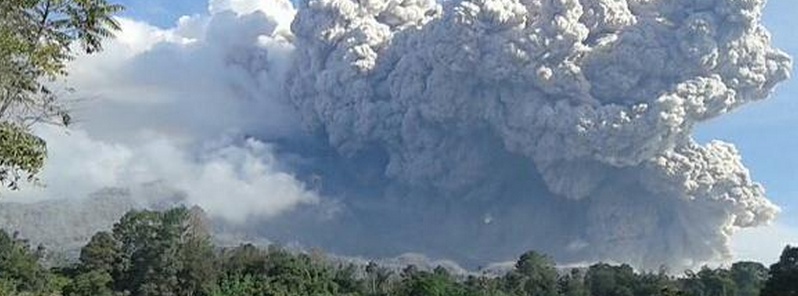Strong eruption and major pyroclastic flow observed at Sinabung volcano, Indonesia

Darwin VAAC reported a high level eruption of Indonesian Sinabung volcano on December 14, 2014. Aviation Color Code was briefly set to Red and later downgraded to Orange as the eruption became less active.
At 02:32 UTC today (09:32 local time) volcanic ash cloud reached an altitude of approximately 6 km, and was extending 18 km to the NW. Last high level erupting was observed at 03:40 UTC.
A large pyroclastic flow, approximately 4.5 km, was observed coming down the volcano yesterday.
#Sinabung 14 Desember 2014 – 09:05am view Payung village cr: Firdaus S @BeidarSinabung @infobencana @chematierra pic.twitter.com/sA1XhpszQd
— Leopold Kennedy Adam (@LeopoldAdam) December 14, 2014
#Sinabun(g) @endrolewa taken from : Tiga Pancur 13/12/2014 – 6:59pm @infobencana @chematierra @pasagmerapi pic.twitter.com/vyfYQLlCI2
— Leopold Kennedy Adam (@LeopoldAdam) December 14, 2014
#Sinabun(g) @endrolewa taken from : Masjid Gamber 13/12 – 4:27pm pyroclastic flow @chematierra @infobencana pic.twitter.com/f6OtObkPDV
— #Sinabung (@SinabungVolcan) December 14, 2014
#Sinabung View masjid gamber. 13 desember 2014 16:33pm @chematierra @infobencana pic.twitter.com/lOCRWfsVko
— Leopold Kennedy Adam (@LeopoldAdam) December 13, 2014
Indonesian Mount Sinabung was sleeping for 400 years before awakening in August 2010. The latest series of eruptions started on September 15, 2013, and continued into 2014.
Two large pyroclastic flows on February 1, 2014, claimed lives of at least 14 people and severely injured 3 others.
Geologic summary
Gunung Sinabung is a Pleistocene-to-Holocene stratovolcano with many lava flows on its flanks. The migration of summit vents along a N-S line gives the summit crater complex an elongated form. The youngest crater of this conical, 2460-m-high andesitic-to-dacitic volcano is at the southern end of the four overlapping summit craters. An unconfirmed eruption was noted in 1881, and solfataric activity was seen at the summit and upper flanks in 1912. No confirmed historical eruptions were recorded prior to explosive eruptions during August-September 2010 that produced ash plumes to 5 km above the summit. (GVP)
Featured image: Sinabung eruption on December 14, 2014. Credit: Firdaus S.

We may not have to wait for the next super volcanoe ti erupt. As far as I understand its the volume of gases & tje height of volcanic ash that triggers global cooling. Also the volume of combined eruptions will also have a bearing & if you look at the last 12 months alone and the 12 month window before those affects are felt. Well let out the long johns honey were gonna need em!!! Im no expert but from what i have picked up here & there we jave more than reached tipping point. Can anyone confirm what im thinking is correct or better sti wrong?? Im afraid but am also prepairing for the worse case scenario as best I can.
Due to Global Warming, plastics in the ocean pollution, and algae blooms from agriculture – all due to humans – I do hope a major volcanic eruption happens in the coming years to drastically cool the planet and fairly reduce the numbers of people which strain the planet’s ecosystem.
” Maybe in our lifetime we my see what happens when a supervolcano blows.” Hopefully this will only occur during the Great Tribulation,after the last trump,which I am making preparations to avoid ! Father, please have mercy on those who do not see the truth or hear words of wisdom.
super volcano going to erupt later than 2030 and I hope that I’m still alive to have experienced it because people do nevejo that Mother Nature is our biggest god that can not be respected…….
I live right next to the island of Fogo Cape Verde ,West Africa the volcano that erupted 2 weeks ago has taken small towns and the lava is still moving forward at 3m per hour a few days ago it was 30 meters ,now seeing this eruption in the Pacific and knowing that all volcanoes are connected who knows when the next eruption maybe but you can count your bottom dollar it is far behind.
Scary to think that the supervolcano under Lake Toba is only about 50 kilometers away from Guning Sinabung. “Lake Toba” last erupted 75,000 years ago with drastic consequences to the Earth’s climate and the direction of mankind (although this has been disputed by some scientists recently). Maybe in our lifetime we my see what happens when a supervolcano blows.